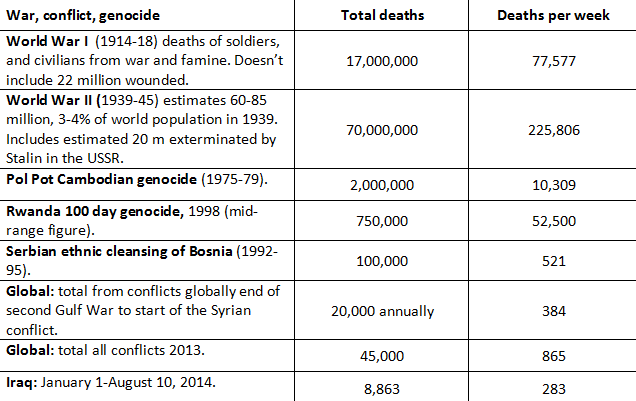So far this year until 10 August, 8,863 people have been killed in the Iraq conflict according tothe web page Iraq Body Count. Its database is based on 36,064 database entries from the beginning of the war to 23 Oct 2013, and on monthly preliminary data subsequently. It also provides a day-by-day account of deaths in the war.
Even with this recent increase, the data on war deaths shows the world experiencing an extraordinary time of relative peace compared to the 20th century.
Professor Goldstein uses data from the Centre for the Study of Civil War at the International Peace Research Institute in Oslo, Norway.
Advertisement
As of August 2014, Goldstein records eight wars (conflicts with more than 1,000 battle-related fatalities in one year) and eight countries with armed conflicts (200-999 deaths in a year).
The International Peace Institute's figures are conservative, including only deaths of combatants and civilians directly killed in conflicts.
The figures don't include civilian deaths from the indirect effects of warfare, such as increased mortality from disease and famine, which are much more difficult to assess.
Also excluded are one-sided violence (genocide, terrorist attacks on civilians) and non-state conflicts (ethnic/sectarian violence), which excludes the millions who died in the Rwandan genocide, the Nazi Holocaust, the Cambodian "killing fields", and the Chinese Cultural Revolution.
Deaths from these other causes have been far fewer in the post-Cold War period. Today, North Korea would be the worst offender.
The contrast between war deaths in the 20th century and recent conflicts is even more dramatic when these other conflict-related deaths are considered, and when war-related deaths are compared to the huge growth in the world's population - from around 1.7 billion at the outbreak of World War I in 1914, to about 7 billion today.
Advertisement
A comparison of various war, conflict and genocide related deaths since 1914

The welcome decline in deaths from war is primarily due to the decline in direct wars between states, a trend that has persisted for over a decade.
Discuss in our Forums
See what other readers are saying about this article!
Click here to read & post comments.
5 posts so far.